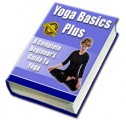Sample Content Preview
Improved brain health – Yoga increases blood flow, which allows more oxygen to get to the brain to improve brain health. In turn, this will boost your memory and encourage your mind to focus more.
Improved heart health – Yoga can lower the risk of heart disease by improving blood circulation or even reducing high blood pressure.
Improved posture – The slow control and holds yoga requires stretches out the spine and effectively increases strength, which will encourage you to keep the correct posture.
Eased chronic pain – The movements promote blood flow and less inflammation, which relaxes the nervous system and releases tension that can be responsible for pain.
Immunity boost – Slow and controlled exercises increase blood flow, heart rate, and concentration to boost your immunity.
Improved mental health – Yoga involves being mindful and aware of your body as you perform each exercise. This helps boost self-esteem and acceptance of one’s self. The stronger you get, the more rewarding your practice will feel.
Improved sleep – Any exercise and especially yoga will improve your sleep. If you are having trouble sleeping, add a routine to your mornings. Avoid exercising at night, however, as this will only increase your energy and make it harder to sleep. You will notice longer and deeper sleep.
Increased flexibility – By far one of the most important benefits you will receive from yoga is added flexibility. The wide range of movement holds and the concentration of the body allow for more flexibility. Flexibility is responsible for many health benefits that you will learn later on in this guide.
If you want to improve your health and increase your flexibility, then getting into yoga is exactly what you need to do. It is straightforward to get started and doesn’t take a lot of your time.
Common Yoga Questions and Answers for Beginners
Before you start practicing yoga, it is vital to understand the basics, what to expect, and where to start. Yoga takes a new outlook on exercising and life in general. It involves more than physically completing the exercise.
First, let’s go over a few common questions that new yogis, or yoginis, have that you may even be wondering yourself:
“Who is yoga best for?”
Yoga can be for just about anyone. This is because all poses can be modified or simply avoided if they are too difficult to perform. Depending on your abilities, it might be best to purchase more products to assist you, especially if you have problems with balance or flexibility. Over time your body will build more strength, and your balance and flexibility will improve.
“How long should I practice each day and how often?”
Again, the great thing about yoga is that it can be adjusted to your needs. When first starting with yoga, it is a good idea to start slowly. The recommended time is usually three times a week at 20 minutes a session. Don’t think you need to dive right in and overdo it right away. Even if you can put in five minutes a day, it’s enough.
“When Is the best time to practice yoga?”
Yoga can be practiced at any time, but it’s best done two to three hours after a meal. This means that morning time is ideal. Yoga requires your body to do a lot of twisting and turning, bending, and concentration, and having a recent meal can upset this.
“What is om-ing and why is it important?”
When you attend a yoga class, you will notice others om-ing at the beginning and end of each session. Om-ing is a vibration sound that helps relax the body and mind and connect us to the sounds and rhythm of the world. Ancient philosophers say that om-ing is found in nature and can always be heard or synchronized.
“I am not flexible so I shouldn’t even do yoga, right?”
Wrong! You should start yoga right away if you think you are not flexible. When you first start, it’s okay not to be flexible. The slow, controlled, and wide range of motions required in yoga build up your flexibility and is the exact reason why many people start practicing yoga in the first place.
Other Details- 1 Ebook (DOC), 20 Pages
- 1 Graphic (PSD, JPG)
- Year Released/Circulated: 2020
- File Size: 6,416 KB
License Details:
What you CAN do:
- You can add the content to an ebook or product that you plan to sell or give away for individual use.
- You can modify the content by removing, adding or otherwise editing to suit your needs.
- You can use the content on your websites, blogs, newsletters or anywhere you publish content.
- You can bundle the content into a viral report, free ebook, product or bonus for your customers.
- You can add your affiliate links, product links, Adsense and other ad code.
- You can charge for access to read this content. For example, a paid ebook, membership site or other paid access content.
What you cannot do:
- You cannot sell this product.













